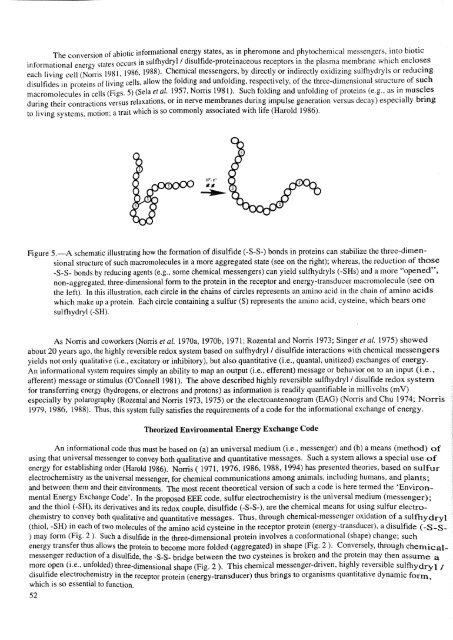View or print this publication - Northern Research Station - USDA ...
View or print this publication - Northern Research Station - USDA ...
View or print this publication - Northern Research Station - USDA ...
You also want an ePaper? Increase the reach of your titles
YUMPU automatically turns print PDFs into web optimized ePapers that Google loves.
The conversion of abiotic inf<strong>or</strong>mational energy states, as in pheromone and phytochemical messengers, into biotic<br />
inf<strong>or</strong>mational energy states occurs in sulfhydryl / disulfide-proteinaceous recept<strong>or</strong>s in the plasma membrane which encloses<br />
each living cell (N<strong>or</strong>ris 1981, 1986, 1988). Chemical messengers, by directly <strong>or</strong> indirectly oxidizing sulfhydryls <strong>or</strong> reducing<br />
disulfides in proteins of living cells, allow the folding and unfolding, respectively, of the three-dimensional structure of such<br />
macromolecules in cells (Figs. 5) (Sela et al. 1957, N<strong>or</strong>ris 1981). Such folding and unfolding of proteins (e.g., as in muscles<br />
during their contractions versus relaxations, <strong>or</strong> in nerve membranes during impulse generation versus decay) especially bring<br />
to living systems, motion; a trait which is so commonly associated with life (Harold 1986).<br />
tt -<br />
(<br />
H,,,- } _<br />
Figure 5.uA schematic illustrating how the f<strong>or</strong>mation of disulfide (-S-S-) bonds in proteins can stabilize the three-dimensional<br />
structure of such macromolecules in a m<strong>or</strong>e aggregated state (see on the right); whereas, the reduction of those<br />
-S-S- bonds by reducing agents (e.g., some chemical messengers) can yield sulfhydryls (-SHs) and a m<strong>or</strong>e "opened",<br />
non-aggregated, three-dimensional f<strong>or</strong>m to the protein in the recept<strong>or</strong> and energy-transducer macromolecule (see on<br />
the/eft). In <strong>this</strong> illustration, each circle in the chains of circles represents an amino acid in the chain of amino acids<br />
which make up a protein. Each circle containing a sulfur (S) represents the amino acid, cysteine, which bears one<br />
sul thydryl (-SH).<br />
As N<strong>or</strong>ris and cow<strong>or</strong>kers (N<strong>or</strong>ris et al. 1970a, 1970b, 1971; Rozental and N<strong>or</strong>ris 1973; Singer et al. 1975) showed<br />
about 20 years ago, the highly reversible redox system based on sulfhydryl / disulfide interactions with chemical messengers<br />
yields not only qualitative (i.e., excitat<strong>or</strong>y <strong>or</strong> inhibit<strong>or</strong>y), but also quantitative (i.e., quantal, unitized) exchanges of energy.<br />
An inf<strong>or</strong>mational system requires simply an ability to map an output (i.e., efferent) message <strong>or</strong> behavi<strong>or</strong> on to an input (i.e ....<br />
afferent) message <strong>or</strong> stinmlus (O'Connell 1981). The above described highly reversible sulfhydryl / disulfide redox system<br />
f<strong>or</strong> transferring energy (hydrogens, <strong>or</strong> electrons and protons) as inf<strong>or</strong>mation is readily quantifiable in millivolts (mV)<br />
especially by polarography (Rozental and N<strong>or</strong>ris 1973, 1975) <strong>or</strong> the electroantennogram (EAG) (N<strong>or</strong>ris and Chu 1974; N<strong>or</strong>ris<br />
1979, 1986, 1988). Thus, <strong>this</strong> system fully satisfies the requirements of a code f<strong>or</strong> the inf<strong>or</strong>mational exchange of energy.<br />
The<strong>or</strong>ized Environmental Energy Exchange Code<br />
An inf<strong>or</strong>mational code thus must be based on (a) an universal medium (i.e., messenger) and (b) a means (method) of<br />
using that universal messenger to convey both qualitative and quantitative messages. Such a system allows a special use of<br />
energy f<strong>or</strong> establishing <strong>or</strong>der (Harold 1986). N<strong>or</strong>ris ( 1971, 1976, 1986, 1988, 1994) has presented the<strong>or</strong>ies, based on sulfur<br />
electrochemistry as the universal messenger, f<strong>or</strong> chemical communications among animals, including humans, and plants;<br />
and between them and their environments. The most recent the<strong>or</strong>etical version of such a code is here termed the 'Environ-<br />
mental Energy Exchange Code'. In the proposed EEE code, sulfur electrochemistry is the universal medium (messenger);<br />
and the thiot (-SH), its derivatives and its redox couple, disulfide (-S-S-), are the chemical means f<strong>or</strong> using sulfur electrochemistry<br />
to convey both qualitative and quantitative messages. Thus, through chemical-messenger oxidation of a sulfhydryl<br />
(thiol, -SH) in each of two molecules of the amino acid cysteine in the recept<strong>or</strong> protein (energy-transducer), a disulfide (-S-S-<br />
) may f<strong>or</strong>m (Fig. 2 ). Such a disulfide in the three-dimensional protein involves a conf<strong>or</strong>mational (shape) change; such<br />
energy transfer thus allows the protein to become m<strong>or</strong>e folded (aggregated) in shape (Fig. 2 ). Conversely, through chemicalmessenger<br />
reduction of a disulfide, the -S-S- bridge between the two cysteines is broken and the protein may then assume a<br />
m<strong>or</strong>e open (i.e., unfolded) three-dimensional shape (Fig. 2 ). This chemical messenger-driven, highly reversible sulfhydryl /<br />
disulfide electrochemistry in the recept<strong>or</strong> protein (energy-transducer) thus brings to <strong>or</strong>ganisms quantitative dynamic f<strong>or</strong>m,<br />
which is so essential to function.<br />
52
















